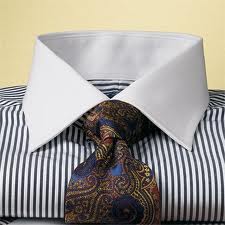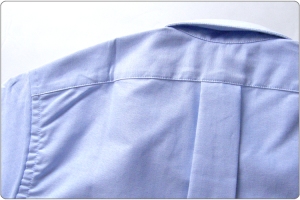So you’ve made the decision to go bespoke . That elusive first customized shirt has now become a reality. Just when everything seems fine and dandy, you realize that there’s a problem. A first world problem, mind you.
You’re now overwhelmed with choice. So let’s present 12 essentials that you should be aware of before diving into the deep end - 12 things to look out for when buying a bespoke shirt.
1. Material – 100% cotton is the best fabric choice. It may wrinkle more than a blend of polyester or cotton, but it breathes, holds dye better and feels luxurious. More information on the intricacies of cotton can be found in my article ‘Combing through Cotton’, but just to highlight, here are a few key points.
- Woven cotton, which is what shirts are made from, is constructed by interlacing threads of the weft and warp (horizontal and vertical threads crossing each other) on a loom
Different types of cotton include:
Egyptian Cotton – Generally regarded as the finest cotton out there, with the longest staple (fibers) of any type of cotton – 1 ½ inches or greater. It is considered soft, silky, strong, absorbs dyes wonderfully and is expensive.
Sea Island – is the American equivalent of Egyptian Cotton, and hence, the next best thing to Egyptian Cottom that is produced within US borders. Sea Island cotton is grown off the islands of South Carolina, Texas and Florida and in the West Indies.
Pima – is also long staple cotton, but is less expensive than Egyptian or Sea Island. Its named after the Pima Indians of the American Southwest, who helped raise it on experimental farms in Arizona in the early 1900’s.
As an example, 2-ply 120 refers to:
- 2 -Ply refers to the yarn count. A single count is one yarn, where as 2 ply indicates that two yarn fibers are twisted together. Using two or more fibers ensures that the quality of the cotton is stronger and more durable
- The 120 refers to the fabric grade. The higher the number, the higher the quality of the yarn.
2. Fabric Weaves - More information on this can be found in my earlier article ‘Different Types of Shirt Fabrics’ – but a few highlights below are:
Broadcloth – A tightly woven fabric with a simple weave, which makes it very dressy.
Oxford – Uses a heavy thread, has a rougher texture, but is more durable. Because its origins lays in in sports, it has been considered the least dressy.
3. Collar – Straight or Point are long narrow collars and are best suited for round or broad faces. The standard length of a straight collar is 2 ¾ inches.
English spread – is the most formal collar and gives you room for a wider tie knot. Its best known for long or narrow faces, and thin necks.
Collar Stays – quality dress shirts have removable collar stays, which hold the collar in proper position and give it some rigidity. These are plastic or metal inserts that go behind the collar. They should be removable and not sewn in. If the stays can’t be removed or you leave them in during wash and iron, a shiny spot will develop on the collar after several ironings.
4. Yoke – The yoke is the strip of material sewn across the shoulders to attach the front to the back of the shirt. Instead of one solid piece of material, the yoke should be two (actually four if you count the double layer of fabric). This split allows for a better fit, creating a natural stretch which moves with you. While a suit has padding to help give it shape from the shoulders down, a shirt does not, and hence, a yoke is the next best alternative. This is why the shoulders of a shirt have close to double the firmness, strength and rigidity of all other parts of a shirt. A yoke also allows a bespoke tailor to carefully manufacture a shirt based on individual differences in shoulder shape (sloped, squared etc), which then provides direction for the rest of the shirt.
5. Seams – Single needle tailoring is used in quality shirt construction for a more durable seam. The seam is sewn along one side and then on the reverse side by the same needle, which results in one line of thread. This gives a clean line and prevents bunching up. The alternative is double needle stitching, which uses two needles at once and produces double lines of thread side by side.
6. Front Placket – is a piece of material on the front of a shirt where the buttonholes are placed, and should be a separate piece of cloth sewn to the front. The placket gives the shirt a definite centerline and provides greater rigidity, so that it is easier to put buttons through the buttonholes.
7. Shirt Body – The best dress shirts are cut full in the body, as it allows greater freedom of movement. However, today, a more tapered look is gaining increasing popularity, and so the choice is ultimately yours! A quality dress shirt should be long, and extend 8-9 inches below the top of your trousers. As a result of this length, quality dress shirts will usually have at least 7 buttons.
8. Back Pleats – Require more fabric from the shirt maker but allow for greater freedom of movement. The most common form of pleat is the center box pleat. Alternatives include side pleats.
9. Buttons – quality dress shirts will often use mother of pearl buttons, which are pleasing to the eye, rich shiny and durable.
10. Sleeves – the sleeve openings of a quality dress shirt will have a button opening about halfway up the sleeve. This serves a functional role and allows the wearer to roll up his sleeves if desired. When not rolled up, this button should be fastened. Unless, of course, you want to strut some arm hair!
11. Cuffs – Cuffs should be sewn in as a separate piece of fabric. There are two primary cuff options, barrel, which is the standard cuff, and french cuff, which has extra fabric allowing the cuff to fold back on itself. A third option is the convertible cuff, which is a combination of the two. A convertible cuff will have another button hole on the button side of the cuff so as to allow the use of cufflinks
12. Pockets – While dress shirts didn’t conventionally have pockets, they have become standard choice for a lot of bespoke wearers these days. Just remember, a shirt with two pockets is not considered a dress shirt! Unless, of course, you’re Chuck Norris.
What do you consider important when buying a Bespoke Shirt? We would love to hear your comments below!
Are you looking for ties that match your various shirt patterns? Given that our core philosophy at The Dark Knot is geared towards helping gentlemen dress better, we have set up an extensive filter where you can find ties based on matching suits and shirts here.
Check out our extensive range of Ties, Pocket Squares and Lapel Flowers here at The Dark Knot!




